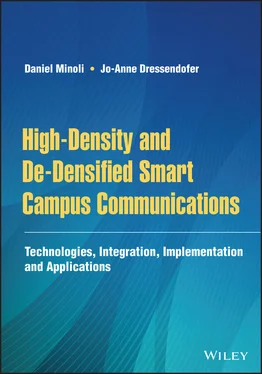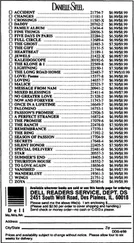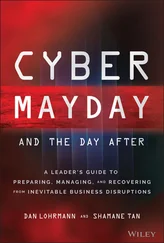13 13. Sakai, E., Yamaura, T., and Sakoda, K. (2019). Radio Communication Apparatus. US Patent 10, 512, 078, 12 December 2019. Uncopyrighted.
14 14. Shaw, K. (2018). What is MU‐MIMO and why you need it in your wireless routers. Networkworld, 26 January 2018 https://www.networkworld.com/article/3250268/what‐is‐mu‐mimo‐and‐why‐you‐need‐it‐in‐your‐wireless‐routers.html
15 15. Choi, H., Ryu, K., Kim, J. et al. (2019). Method and Device For Transmitting And Receiving Frame Related To Multi‐User Transmission In Wireless LAN System. US Patent 10, 524, 287, 31 December 2019. Uncopyrighted.
16 16. Tutorialspoint Staff. Inter – frame spaces (RIFS, SIFS, PIFS, DIFS, AIFS, EIFS). https://www.tutorialspoint.com/inter‐frame‐spaces‐rifs‐sifs‐pifs‐difs‐aifs‐eifs
17 17. Staff. FEC Coding. https://www.wlanpedia.org/tech/phy/coding‐bcc‐ldpc(accessed 6 March 2020.
18 18. IEEE. IEEE 802.11ac‐2013 ‐ IEEE Standard for Information technology – Telecommunications and information exchange between systems – Local and metropolitan area networks – Specific requirements – Part 11: Wireless LAN Medium Access Control (MAC) and Physical Layer (PHY) Specifications – Amendment 4: Enhancements for Very High Throughput for Operation in Bands below 6 GHz. https://standards.ieee.org/standard/802_11ac‐2013.html.
19 19. Aruba Staff. (2014). 802.11ac In‐Depth White paper. https://www.arubanetworks.com/assets/wp/WP_80211acInDepth.pdf(accessed 30 October 2020).
20 20. Zhou, Y. and Pramod, A. (2018). Distributed MIMO Communication Scheduling In An Access Point Cluster. US Patent 10, 820, 333; 27 October 2020; filed 8 March 2018. Uncopyrighted.
21 21. Qualcomm Staff. 802.11ac MU‐MIMO: Bridging the MIMO Gap in Wi‐Fi. White Paper; January 2015; Qualcomm Atheros, Inc., 1700 Technology Drive, San Jose, CA 95110. https://www.qualcomm.com/media/documents/files/802‐11ac‐mu‐mimo‐bridging‐the‐mimo‐gap‐in‐wi‐fi.pdf(accessed 11 November 2020).
22 22. Gridelli, S. (2018). How to Use DFS Channels in WiFi. 05 December 2018. https://netbeez.net/blog/dfs‐channels‐wifi(accessed 30 October 2020).
23 23. Tarokh, V., Jafarkhani, H., and Calderbank, A.R. (1999). Space–time block codes from orthogonal designs. IEEE Transactions on Information Theory 45 (5) https://doi.org/10.1109/18.771146.
24 24. Foschini, G. and Gans, M. (1998). On limits of wireless communications in a fading environment when using multiple antennas. Wireless Personal Communications 6: 311–335. https://doi.org/10.1023/A:1008889222784.
25 25. Tarokh, V., Seshadri, N.I., and Calderbank, A.R. (1998). Space–time codes for high data rate wireless communication: performance analysis and code construction. IEEE Transactions on Information Theory 44 (2) https://doi.org/10.1109/18.661517.
26 26. Alamouti, S.M. (1998). A simple transmit diversity technique for wireless communications. IEEE Journal on Selected Areas in Communications 16 (8) https://doi.org/10.1109/49.730453.
1 1 While this text focuses on the extension of traditional technologies, newer technologies may also become important in the intermediate future (these new technologies include among others: multiple access schemes aimed at increasing the spectrum efficiency, user experienced data rate, system capacity, and connection density). Examples of new technologies include Sparse Code Multiple Access, Multiuser Shared Access, Pattern Division Multiple Access, and Resource Spread Multiple Access; new signal waveforms such as filtered OFDM, window‐OFDM, Universal Filtered Multicarrier; novel channel coding such as polar coding and Low‐Density Parity Check coding; and software‐defined air interface also in conjunction with end‐to‐end network slicing [1].
2 2 Some portions of this chapter are based on reference [2].
3 3 These figures refer to the raw PHY speed. The cited 6.97 Gbps figure would need an AP to operate on the 160 MHz channels (e.g. channel 50 or 114); other arrangements (e.g. 80 MHz channel using 8 × 8 MIMO on channels 42, 58, 106, 122, 138, 155, or 171) provide a maximum speed of 3.4 Gbps; however, a more conservative maximum speed is 1.7 Gbps on an 80 MHz channel using 4 × 4 MIMO; observers note that although one can find 4 × 4 Wi‐Fi Network Interface Cards for PCs, a much more realistic maximum PHY speed for devices using batteries and not line power is 866 Mbps for an 80 MHz channel with a 2 × 2 client.
4 4 Layer 1 has two sublayers: the Physical Layer Convergence Procedure (PLCP) and the Physical Medium Dependent (PMD) (note at the same time Layer 2 has two sublayers: the Logical Link Control [LLC] and the MAC). A description of PHY sublayers follows from [11]:PLCP Sublayer: the MAC layer communicates with the PLCP sublayer via primitives (a set of “instructive commands” or “fundamental instructions”) through a Service Access Point (SAP). When the MAC layer instructs it to do so, the PLCP prepares MAC Protocol Data Units (MPDUs) for transmission. The PLCP minimizes the dependence of the MAC layer on the PMD sublayer by mapping MPDUs into a frame format suitable for transmission by the PMD. The PLCP also delivers incoming frames from the wireless medium to the MAC layer. The PLCP appends a PHY‐specific preamble and header fields to the MPDU that contain information needed by the PHY layer transmitters and receivers. The 802.11 standard refers to this composite frame (the MPDU with an additional PLCP preamble and header) as a PLCP Protocol Data Unit (PPDU). The MPDU is also called the PLCP Service Data Unit (PSDU) and is typically referred to as such when referencing PHY layer operations. The frame structure of a PPDU provides for asynchronous transfer of PSDUs between stations. As a result, the receiving station's PHY must synchronize its circuitry to each individual incoming frame.PMD Sublayer: under the direction of the PLCP, the PMD sublayer provides transmission and reception of PHY layer data units between two stations via the wireless medium. To provide this service, the PMD interfaces directly with the wireless medium (that is, RF in the air) and provides modulation and demodulation of the frame transmissions. The PLCP and PMD sublayers communicate via primitives, through an SAP, to govern the transmission and reception functions.
5 5 “Stream” refers to spatial concepts: streams are used for per client Wi‐Fi communication (multiple antenna communication); “channel” refers to the RF facility used to support simultaneous MU Wi‐Fi client communications; there are two or three bands in recent AP hardware that uses 2.4 GHz and one or two 5 GHz – the so‐called Dual‐Band APs or the so‐called Tri‐Band APs.
Конец ознакомительного фрагмента.
Текст предоставлен ООО «ЛитРес».
Прочитайте эту книгу целиком, купив полную легальную версию на ЛитРес.
Безопасно оплатить книгу можно банковской картой Visa, MasterCard, Maestro, со счета мобильного телефона, с платежного терминала, в салоне МТС или Связной, через PayPal, WebMoney, Яндекс.Деньги, QIWI Кошелек, бонусными картами или другим удобным Вам способом.












